Ad Blocker Detected
Our website is made possible by displaying online advertisements to our visitors. Please consider supporting us by disabling your ad blocker.
1. Kon Tum Travel – Geographical location:
Kon Tum Travel – Kon Tum is a mountainous, border province, located in the northern Central Highlands in geographical coordinates from 107020’15” to 108032’30” east longitude and from 13055’10” to 15027’15” north latitude. .
Kon Tum has a natural area of 9,676.5 km2, accounting for 3.1% of the national area, bordering Quang Nam province to the north (boundary length 142 km); The south borders Gia Lai province (203 km), the east borders Quang Ngai (74 km), the west borders Laos and Cambodia (sharing a common border of 280.7 km).
2. Natural conditions:
Topographic:
Most of Kon Tum province lies west of the Truong Son range, the terrain gradually lowers from north to south and from east to west. The terrain of Kon Tum province is quite diverse: alternating hills, plateaus and lowlands. In there:
1) Hilly and mountainous terrain: accounts for about 2/5 of the entire province’s area, including continuous hills and mountains with slopes of 150 degrees or more. The mountains in Kon Tum are made of ancient metamorphic rocks, so they have a block shape like the Ngoc Linh block (with Ngoc Linh peak 2,598 m high) – the origin of many rivers flowing to Quang Nam and Da Nang such as the Thu Bon and Da Nang rivers. Vu Gia River; flows to Quang Ngai like Tra Khuc River.
Continuous high mountain terrain is distributed mainly in the north – northwest running to the east of Kon Tum province. In addition, Kon Tum also has a number of mountains such as: Bon San mountain (1,939 m); Ngoc Kring mountain (2,066 m). The terrain is dangerously dissected, forming narrow valleys, ravines, and streams. The hilly terrain is concentrated mainly in Sa Thay district, tilting to the west and gradually lowering to the southwest, alternating between the hills is the Chumomray mountain range.
2) Valley topography: located along the Po Ko River to the south of the province, has a trough shape that gradually lowers to the south, along the valley there are wavy hills such as Dak Uy, Dak Ha and many surface areas. flat like Kon Tum city area. Sa Thay Valley is formed between mountain ranges stretching to the east along the Vietnam – Cambodia border.
3) Plateau terrain: Kon Tum province has the Kon Plong plateau located between the An Khe range and Ngoc Linh range with an altitude of 1,100 – 1,300 m. This is a small plateau, running in the Northwest – Southeast direction.
Climate:
Kon Tum belongs to the tropical monsoon climate zone of the highlands. The average temperature during the year ranges from 22 – 230C, with a daily temperature range of 8 – 90C.
Kon Tum has 2 distinct seasons: the rainy season mainly starts from April to November, the dry season from December to March of the following year. Every year, the average rainfall is about 2,121 mm, the highest annual rainfall is 2,260 mm, the lowest annual rainfall is 1,234 mm, the month with the highest rainfall is August. In the dry season, the wind is mainly northeast; In the rainy season, the wind is mainly southwest.
The average annual humidity fluctuates between 78 – 87%. The highest month of air humidity is August – September (about 90%), the lowest month is March (about 66%).
Mineral:
Kon Tum is located on the Kon Tum uplift, so it is very diverse in geological structure and minerals. In the area, there are 21 stratigraphic units and 19 magma complexes that have been researched and established by geologists, a series of minerals such as iron, chromium, gold, refractory materials, gems, Precious metals, radioactive metals, rare earths, raw materials for the production of construction materials, etc. have been discovered. Many areas with mineral prospects are being investigated to establish geological maps at a scale of 1/50,000, along with other thematic research projects,… which will be an important basis in development planning. local socio-economic. Through surveys by specialized agencies, currently, Kon Tum is focusing on some of the following minerals:
1) Group of minerals serving the production of construction materials: this group is very diverse, including: clay (bricks and tiles), construction sand, pebbles, marble, limestone, granite, pozzolan,… .
2) Mineral group of soundproofing, heat insulation and environmental treatment materials, including diatomite, bentonite, mainly concentrated in Kon Tum city.
3) Refractory mineral group: includes silimanite, dolomite, quartzite concentrated mainly in Dak Glei, Dak Ha, Ngoc Hoi districts.
4) Fire minerals group: includes peat, concentrated mainly in Kon Tum city, Dak Ha district, Dak To district.
5) Group of ferrous metals, non-ferrous metals, and rare metals: including manganese in Dak Ha; tin, molybdenum, tungsten, uranium, thorium, concentrated mainly in Dak To, Dak Glei, Ngoc Hoi, Konplong; Bauxite is concentrated mainly in Kon Plong.
6) Gem mineral group: includes ruby, sapphire, opalcalcedon concentrated in Dak To and Konplong.

Land resources:
Kon Tum province’s land resources are divided into 5 groups with 17 main land types:
1) Alluvial soil group: includes three main types of soil: alluvial soil, patchy alluvial soil, and alluvial soil outside streams.
2) Gray soil group: includes two main types of soil: gray soil on acid magma and gray soil on ancient alluvium.
3) Yellow soil group: includes 6 main types: yellow-brown soil on ancient alluvium, yellow-red soil on acid magma, yellow-red soil on clay and metamorphic rocks, red-brown soil on weathered basalt rocks, light yellow soil on rocks sand and purple-brown soil on basalt.
4) Yellow humus group on mountains: includes 5 main types of soil: light yellow humus soil with Potzonation, light yellow humus soil on clay and metamorphic rocks, reddish brown humus soil on basic and neutral magma, red yellow humus soil on acid magma.
5) Valley soil group: there is only one main type of soil, valley soil with concentrated slope products.
Water Resources:
1) Surface water sources: mainly rivers and streams originating from the north and northeast of Kon Tum province, often with steep beds, narrow valleys, and fast-flowing water, including:
– Se San River: formed by two main branches, Po Ko and Dakbla. Po Ko branch is 121 km long, originating from the south of Ngoc Linh massif, flowing in a north – south direction. This branch is supplied from the 73 km long DakPsy stream, originating south of Ngoc Linh mountain from Ngoc Lay and Mang Ri communes, Dak To district. The 144 km long Dakbla branch originates from the Ngoc Krinh mountain range.
– Other rivers and streams: In the northeast of the province is the source of Tra Khuc river flowing to Quang Ngai and in the north of the province is the source of two rivers Thu Bon and Vu Gia flowing to Quang Nam and Da Nang. There is also the Sa Thay River originating from the top of Ngoc Rinh Rua mountain, flowing north – south, almost parallel to the Cambodian border, pouring into the Se San stream.
In general, the water quality, potential energy,… of surface water sources are favorable for the construction of hydroelectric and irrigation projects.
2) Groundwater source: Groundwater source in Kon Tum province has potential and industrial reserves of C2 level: 100 thousand m3/day, especially at a depth of 60 – 300 m with relatively large reserves. In addition, Dak To and Konplong districts also have 9 locations with hot mineral water that can be exploited and used as beverage and treatment.
Forest resources:
By 2008, Kon Tum’s forestry land area was 660,341 hectares, accounting for 68.14% of the natural area. Kon Tum has the following main forest types:
– Tropical closed mixed forest with trees and broad leaves: this is a typical forest type of Kon Tum province’s forests, distributed mainly at an altitude of 500 m, found in most districts and towns in the province.
– Tropical moist leafy forests: found mostly in the province and often distributed along rivers.
– Subtropical closed forests: distributed in high mountains.
– Dry sparse forests of dipterocarp plants (drip forests): distributed mainly in Ngoc Hoi district, Dak Glei district (along the borders of Vietnam, Laos, and Cambodia).
– Plants: According to initial survey results, Kon Tum province has more than 300 species, belonging to more than 180 genera and 75 families of flowering plants. Gymnosperms have 12 species, 5 genera, 4 families; Angiosperms have 305 species, 175 genera, 71 families; Monocot plants have 20 species, 19 genera, 6 families; 2-leafed tree with 285 species, 156 genera, 65 families.
Among them, the most numerous families are the bean family, the oil family, the camphor family, the castor family, the chamois family, the peach family, the acanthus family and the canary family. In general, the vegetation in Kon Tum is diverse, showing many different types of forests in the general background of the tropical monsoon forest zone, with 3 different high and low belts: 600 m or less, 600 – 1,600 m and over 1,600 m. Currently, the most prominent forest is still the jungle. In the jungle, the main populations are two-leaf pine, chestnut, re, pomu, azalea, sour,… at an altitude of 1,500 – 1,800 m, mainly three-leaf pine. leaves, sour, chestnut, re, khao, chec,…
Referring to the forest resources in Kon Tum, we must mention the Ngoc Linh mountain area with precious medicinal plants such as Ngoc Linh ginseng, ginseng, polygonum and cinnamon. In recent years, Kon Tum’s forest area has shrunk due to war and illegal exploitation of wood and other forest products. But in general, Kon Tum is still a province with many precious wood forests and high economic value.
– Animals: very rich and diverse, including many rare species, including birds with 165 species, 40 families, 13 orders, enough for most bird species; There are 88 species of mammals, 26 families, 10 orders, accounting for 88% of mammal species in the Central Highlands.
The most notable are herbivores such as elephants, bison, gaur, wild buffalo, deer, muntjac, etc. Among them, elephants are abundant in the southwest of Kon Tum (Sa Thay district). Bison include: gaur (or min), scientific name Bosgaurus, which often appears in the forests of Sa Thay and Dak To districts; Black Teng cow scientific name Bosjavanicus. In recent years, tigers have appeared in Sa Thay, Dak To, and Kon Plong, which is a good sign of the existence of this precious animal. In addition, Kon Tum forest also has sun bears, black bears, and wolves.
Besides mammals, Kon Tum also has many precious birds that need to be protected such as peacocks, star pheasants, purple pheasants and striped pheasants. In conditions where forests are being violated, illegal hunting is increasing, and the ever-changing environment has affected the survival of animals, especially rare animals. Kon Tum province has planned to build primeval forests and put them into national rankings to have plans for exploitation, research and protection, while promoting propaganda, education, and raising awareness of conservation. protect animals and plants in particular and the ecological environment in general.


